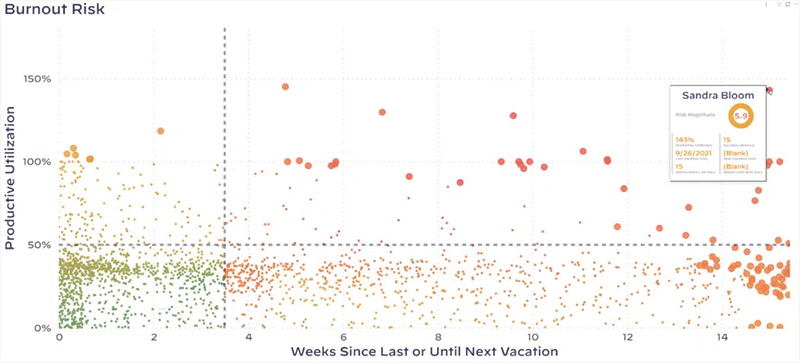
Running a professional services firm is inherently a human endeavor. It’s all about people—hiring, developing, and retaining very smart, highly skilled, passionate, and almost always well-paid consultants. It’s no surprise then, that one of the key areas that differentiates a thriving consulting business from its less successful peers is its ability to minimize employee attrition and maximize engagement and retention.
This post provides a quick overview of how we think about reducing employee turnover, but if you’re interested in a deeper exploration, check out our white paper, FIGHTING THE GREAT RESIGNATION: How to Maximize Employee Retention in the Face of Macroeconomic Headwinds.
Comparing Employee Attrition Versus Employee Turnover
Human resources specialists often draw a distinction between attrition and turnover based on whether or not the company elects to backfill a role vacated by an employee who quits. This difference is often overlooked or minimized by generalists mostly because the disruption it causes to a professional services firm is often similar in either case.
It boils down to either transferring skills, knowledge, and workloads from the employee who is leaving to remaining employees or new hires or alternatively foregoing some billable work because supply can’t meet demand. Either way, both attrition and turnover are disruptive and expensive to the business, and some estimates place the cost of replacing a consultant at $150,000 per person.

Identifying the Primary Cause of Employee Attrition
Much has been written about why employees are leaving existing jobs in droves, leading to concerns about “The Great Resignation” or “The Turnover Tsunami.” While these headlines may sound like hyperbole, there’s a lot of evidence to back up the trends. A recent Pulse Survey by Price Waterhouse Coopers estimates that as many as two-thirds of your workforce may be out looking for a new job as we speak.
Digging a little deeper, a recent study in Harvard Business Review found burnout to be one of the largest drivers of The Great Resignation. This was particularly prevalent in the highest turnover industries such as the technology sector, where the employee attrition rate in the age of COVID, and all the pressures that accompanied it, increased 4.5% over the prior year.
Quantifying Employee Burnout
This notion of employee burnout causing attrition is supported by primary research that we conducted on tens of thousands of consultants managed in our Professional Services Automation platform which is targeted specifically at the professional services industry. By helping services firms manage the projects that underlie the revenue-generating efforts of the company as well as the people that are delivering those projects, Projector by BigTime can provide tremendous quantitative insights into both those areas.
To illuminate the factors that led to employee attrition, we examined the people side of the business more closely. Specifically, we looked through the characteristics of consultants who left their positions and compared them to those who stayed. In doing this, two main trends emerged that pointed directly at burnout as a major attrition risk.
The first was all about time off taken… curiously enough, not the amount of vacation time, but how frequently or recently the consultant had taken a break. It turns out that for consultants who left, over half of them had not taken a vacation day in over four months as compared to a median of two months without time off for employees who stayed. So, frequency and recency matters, even more than amount.
The second was about workloads, often measured by consulting firms in the form of utilization. Utilization is all about the percentage of a person’s time that is spent generating revenue or performing work that is important to the firm. While there are multiple ways that systems can measure utilization, all the data pointed to the fact that employees who left were between 18% and 23% busier than those who stayed.
Modeling Attrition Risk
The good news here is that once we can develop a credible method to measure burnout quantitatively, we have the ability to predict turnover through an attrition risk model. Systems like Projector by BigTime can manage the whole employee lifecycle, from being hired and getting assigned to a project to scheduling breaks between projects and taking time off. With all of this data, coupled with its analytical and dashboarding capabilities, Projector by BigTime can provide all the data that would feed into an attrition risk model to identify employees most at risk of burnout:

The even better news is that because it looks not just in the past, but into the future, Projector by BigTime can turn this sort of burnout risk scoring into a leading indicator, not just a lagging measure. After all, the whole point of identifying consultants at risk is to proactively address the issue while interventions can still be effective.
Digging Deeper
In short, minimizing employee attrition and maximizing retention boils down to a seemingly simple three-step process:
- Understand the root causes of attrition
This may be different industry by industry, but in our research in a professional services environment, burnout was the primary cause of employee turnover. - Quantify the root causes of attrition
Gather data that is consistent and accurate that can be used as predictive indicators of resource attrition. - Model attrition risk to enable proactive intervention
Compile the data into a practical attrition risk model that can be used to proactively manage threats to employee retention.
While this was just a high-level summary of our journey towards helping our clients deal with the very real threat of increased employee turnover, as always, the devil is in the details. If you’re interested in a deeper discussion of this topic, check out our white paper, FIGHTING THE GREAT RESIGNATION: How to Maximize Employee Retention in the Face of Macroeconomic Headwinds. This piece delves deeper into some of the macroeconomic trends affecting attrition, how those trends are affecting the services industry, what additional attrition risks were found in our primary research, and what can be done to minimize them.
Best of luck in your journey towards hiring, developing, and retaining a world-class professional services team. Let us know if you’d be interested in learning how BigTime Software’s Professional Services Automation platform can assist you in that quest!
.png)
Frequently Asked Questions About Employee Attrition
What causes employee attrition?
A recent study in Harvard Business Review found burnout to be one of the largest drivers of employee attrition and The Great Resignation. This was particularly prevalent in the highest turnover industries such as the technology sector, where the employee attrition rate in the age of COVID, and all the pressures that accompanied it, increased 4.5% over the prior year.
What are the factors of attrition rate?
Our research indicates three main factors that affect attrition rate, specifically in the professional services industry:
1. Time off
2. Workloads
3. Professional development
What’s the difference between employee turnover and attrition?
Human resource specialists often draw a distinction between employee attrition and turnover based on whether the company elects to backfill the role of a vacated employee. Attrition occurs when the company does not plan to backfill a role vacated by an employee who voluntarily quits. Turnover occurs when a company plans to replace voluntarily or involuntarily vacated roles.
What is employee attrition rate?
Employee attrition rate is calculated by dividing the number of people who have vacated a role by the average number of employees at the company, multiplied by 100.
How can you manage employee attrition and turnover?
Three steps to minimizing employee attrition and maximizing retention include:
1. Understand the root causes of attrition
2. Quantify the root causes of attrition
3. Model attrition risk to enable proactive intervention




